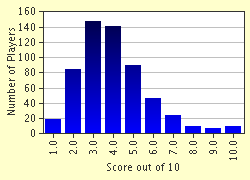Quiz Answer Key and Fun Facts
1. Which was the only U.S. Army Airborne unit to see combat in the Korean War?
2. How many U.S. Air Force B-29 bombers were lost in the Korean War?
3. On which Parallel is the DMZ that divides North and South Korea?
4. Not counting the U.S. and the Republic of South Korea, how many United Nations Countries sent combat troops to Korea?
5. Which is 'NOT' a battle of the Korean War?
6. Which was the Commanding General of the U.S. Army's X Corps in the Korean War?
7. Which U.S. Air Force Jet Fighter shot down a MIG-15 in the world's first all-jet dogfight in the Korean War?
8. Which was the target for the largest air strike of the Korean War?
9. Who replaced Lt. General Matthew B. Ridgway as Commander of the Eighth U.S. Army in April 1951?
10. Who signed the Armistice for the United Nations ending the Korean War on July 27, 1953?
Source: Author
Regor
This quiz was reviewed by FunTrivia editor
trammgr before going online.
Any errors found in FunTrivia content are routinely corrected through our feedback system.

